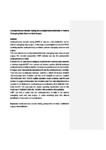Cardiopulmonary exercise testing and cardiopulmonary morbidity in patients undergoing major head and neck surgery
| dc.contributor.author | Lalabekyan, BB | |
| dc.contributor.author | Tetlow, N | |
| dc.contributor.author | Moonesinghe, R | |
| dc.contributor.author | Martin, Daniel | |
| dc.contributor.author | Burdett, E | |
| dc.contributor.author | Otto, J | |
| dc.contributor.author | Wyndham, D | |
| dc.contributor.author | Bettini, E | |
| dc.contributor.author | Kalavrezos, N | |
| dc.contributor.author | Stephens, RCM | |
| dc.date.accessioned | 2020-09-18T10:37:22Z | |
| dc.date.available | 2020-09-18T10:37:22Z | |
| dc.date.issued | 2021-04 | |
| dc.identifier.issn | 0266-4356 | |
| dc.identifier.issn | 1532-1940 | |
| dc.identifier.uri | http://hdl.handle.net/10026.1/16385 | |
| dc.description.abstract |
Cardiopulmonary exercise testing (CPET) is used as a risk stratification tool for patients undergoing major surgery. In this study, we investigated the role of CPET in predicting day five cardiopulmonary morbidity in patients undergoing head and neck surgery. This observational cohort study included 230 adults. We recorded preoperative CPET variables and day five postoperative cardiopulmonary morbidity. Full data from 187 patients were analysed; 43 patients either had incomplete data sets or declined surgery/CPET. One hundred and nineteen patients (63.6%) developed cardiopulmonary morbidity at day five. Increased preoperative heart rate and duration of surgery were independently associated with day five cardiopulmonary morbidity. Those with such morbidity also had lower peak V̇O2 11.4 (IQR 8.4-18.0) vs 16.0 (IQR 14.0-19.7) ml.kg-1.min-1, P<0.0001 and V̇O2 at AT 10.6 (IQR 9.1-13.1) vs 11.5 (IQR 10.5-13.0) ml.kg-1.min-1, p=0.03. Logistic regression model containing peak V̇O2 and duration of surgery demonstrated that increased peak V̇O2 was associated with a reduction in the likelihood of cardiopulmonary complications OR 0.92 (95%CI 0.87 to 0.96), p=0.001. The area under the receiver operating characteristic curve for this model was 0.75(95%CI 0.68 to 0.82), p<0.0001, 64% sensitivity, 81% specificity. CPET can help to predict day five cardiopulmonary morbidity in the patients undergoing head and neck surgery. A model containing peak V̇O2 allowed identification of those with such complications. | |
| dc.format.extent | 297-302 | |
| dc.format.medium | Print-Electronic | |
| dc.language | en | |
| dc.language.iso | en | |
| dc.publisher | Elsevier BV | |
| dc.subject | Cardiopulmonary exercise testing | |
| dc.subject | postoperative morbidity | |
| dc.subject | maxillofacial surgery | |
| dc.subject | risk stratification | |
| dc.title | Cardiopulmonary exercise testing and cardiopulmonary morbidity in patients undergoing major head and neck surgery | |
| dc.type | journal-article | |
| dc.type | Journal Article | |
| dc.type | Observational Study | |
| plymouth.author-url | https://www.webofscience.com/api/gateway?GWVersion=2&SrcApp=PARTNER_APP&SrcAuth=LinksAMR&KeyUT=WOS:000634567800010&DestLinkType=FullRecord&DestApp=ALL_WOS&UsrCustomerID=11bb513d99f797142bcfeffcc58ea008 | |
| plymouth.issue | 3 | |
| plymouth.volume | 59 | |
| plymouth.publication-status | Published | |
| plymouth.journal | British Journal of Oral and Maxillofacial Surgery | |
| dc.identifier.doi | 10.1016/j.bjoms.2020.08.032 | |
| plymouth.organisational-group | /Plymouth | |
| plymouth.organisational-group | /Plymouth/Faculty of Health | |
| plymouth.organisational-group | /Plymouth/REF 2021 Researchers by UoA | |
| plymouth.organisational-group | /Plymouth/REF 2021 Researchers by UoA/UoA01 Clinical Medicine | |
| plymouth.organisational-group | /Plymouth/Users by role | |
| plymouth.organisational-group | /Plymouth/Users by role/Academics | |
| dc.publisher.place | Scotland | |
| dcterms.dateAccepted | 2020-08-10 | |
| dc.rights.embargodate | 2022-2-13 | |
| dc.identifier.eissn | 1532-1940 | |
| dc.rights.embargoperiod | Not known | |
| rioxxterms.versionofrecord | 10.1016/j.bjoms.2020.08.032 | |
| rioxxterms.licenseref.uri | http://www.rioxx.net/licenses/all-rights-reserved | |
| rioxxterms.licenseref.startdate | 2021-04 | |
| rioxxterms.type | Journal Article/Review |


